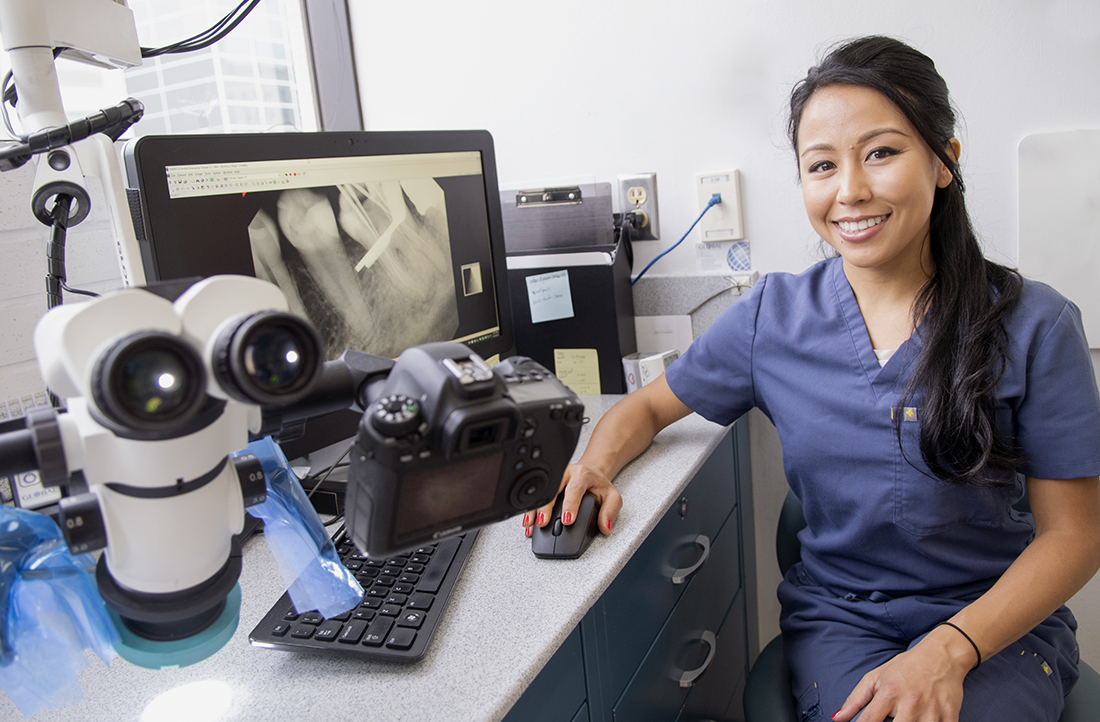Reaching out

The endodontic program at Texas A&M College of Dentistry is well-known for its dedication to excellence and its inherent rigor. Between treating patients in the third-floor endodontic clinic and occasionally offsite at Children’s Health, graduate students in this specialty also teach second-year dental students in the Undergraduate Endodontic Sim Lab when they’re not in class themselves. First-year graduate student Dr. Lindsey Chang now has another role to add to this list: member of the Resident Expert Advisory Council — REACH — of the Foundation for Endodontics, the charitable arm of the American Association of Endodontists.
The foundation has been in existence since 1966 with a primary goal of raising funds to further develop the specialty, and in recent years, members have made a concerted effort to better understand the next generation of endodontists. It’s the impetus behind founding REACH in 2015.
As one of 10 endodontic graduate students nationwide selected to serve on the council, Chang will engage her peers at dental schools stretching from Alabama to Arizona, spreading awareness about the educational and financial resources the foundation has to offer, all the while encouraging humanitarian endeavors. One of the most sought-after activities: dental mission trips to Treasure Beach, Jamaica, which occur several times a year. For Chang, who is from Jamaica and helped establish a dental mission trip to Kingston that eventually moved to the same clinic where the foundation now sends REACH members, the council’s outreach and service mandate comes naturally.
A 2013 University of Florida College of Dentistry graduate, Chang is uniquely positioned to serve in this role. Two years of hiring and leading a new team in the private-practice sector was followed by an opportunity to serve patients through the U.S. Department of Veterans Affairs. It was a career move that, in a roundabout way, would lead Chang to endodontics.
“All of the patients at the VA are medically compromised,” says Chang. “The access to care is so limited there, but across the board, all patients want is a doctor who really cares about them and doesn’t make them feel like just another number.”
While the two years spent at the VA offered rewarding patient relationships and ample surgical experience, something was missing.
“I didn’t get to do endo for those two years, even though I loved it there,” says Chang. “When you have a passion for something, it’s just all you want to do. I can’t imagine a path that did not lead me here, to an endodontic residency.”
Dr. Gerald Glickman, department head and graduate endodontic program director, nominated Chang for the REACH position when she expressed her interest in the council.
“Lindsey brings a sense of maturity along with a sincere desire to help the underserved, especially in regard to saving the natural dentition,” Glickman says. “Her years of working at the VA prior to entering residency probably helped her appreciate the importance of maintaining the natural dentition. In addition, Lindsey has developed very good communication skills that will enable her to be successful on the council.”
Chang’s two-year term will conclude in October 2019 when she finishes the endodontic program. She just returned from the AAE annual meeting in late April, where she met the other nine members of the council. Now outreach can begin.
“When you think about it, our graduate programs shape all of us,” says Chang. “Do we leave supported, do we care about networking or having organized dentistry? Do we care about giving back to our communities? I’m excited to have a voice in that. It might be eye-opening for many, and I’m interested to see what changes come from it all.”
What does an endodontist do?
Summing up the mission of this dental specialty is simple, really: “We save teeth,” says Lindsey Chang, endodontics graduate student and member of the Resident Expert Advisory Council for the American Association of Endodontists’ foundation. And while that often involves root canals, there are other approaches.
“We can surgically treat teeth,” Chang explains. “Instead of going through the crown, we go directly to the root end. We also do replantation procedures, where teeth are extracted and treated outside the mouth and then re-inserted back into their original position or into a new desired site.
“But at the end of the day, there is nothing more fulfilling in the dental field than to get someone out of pain and on a path to a healthier mouth.”